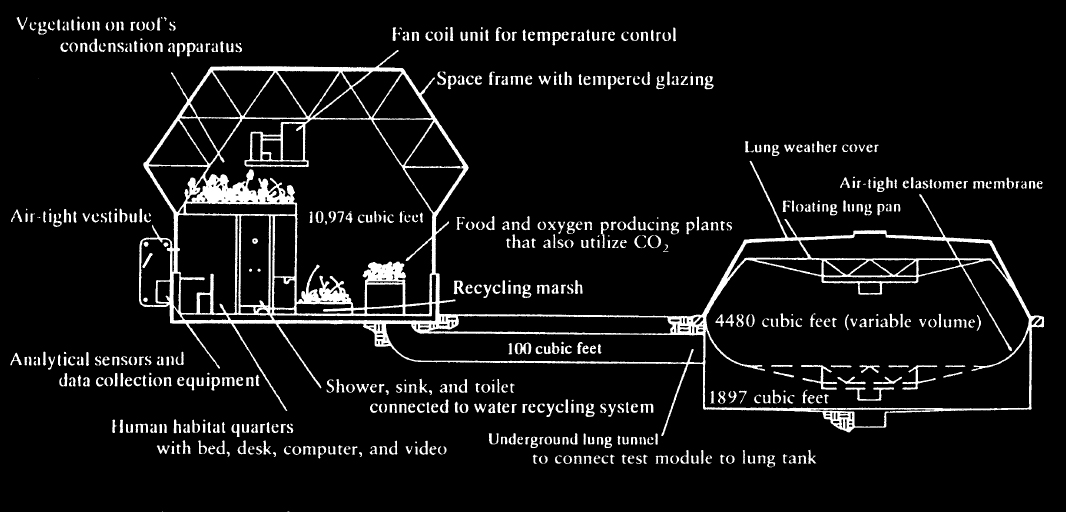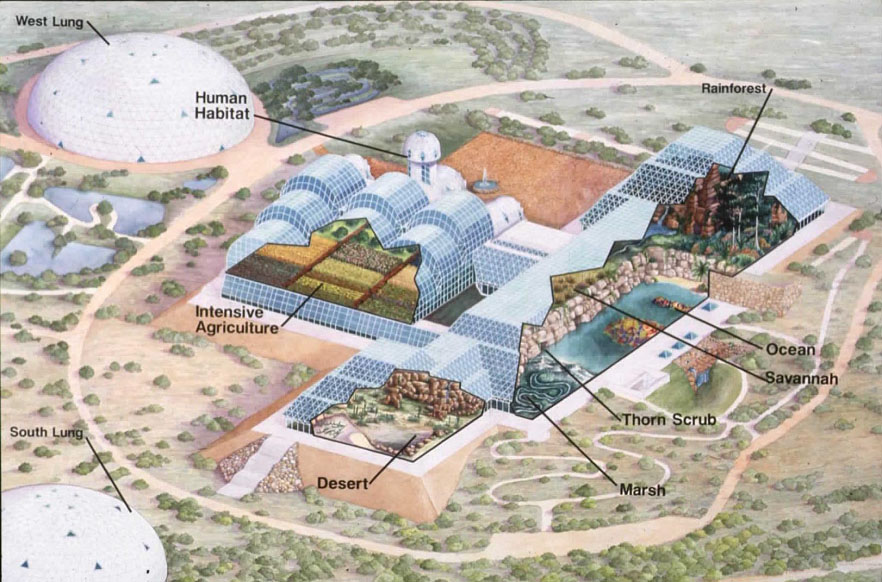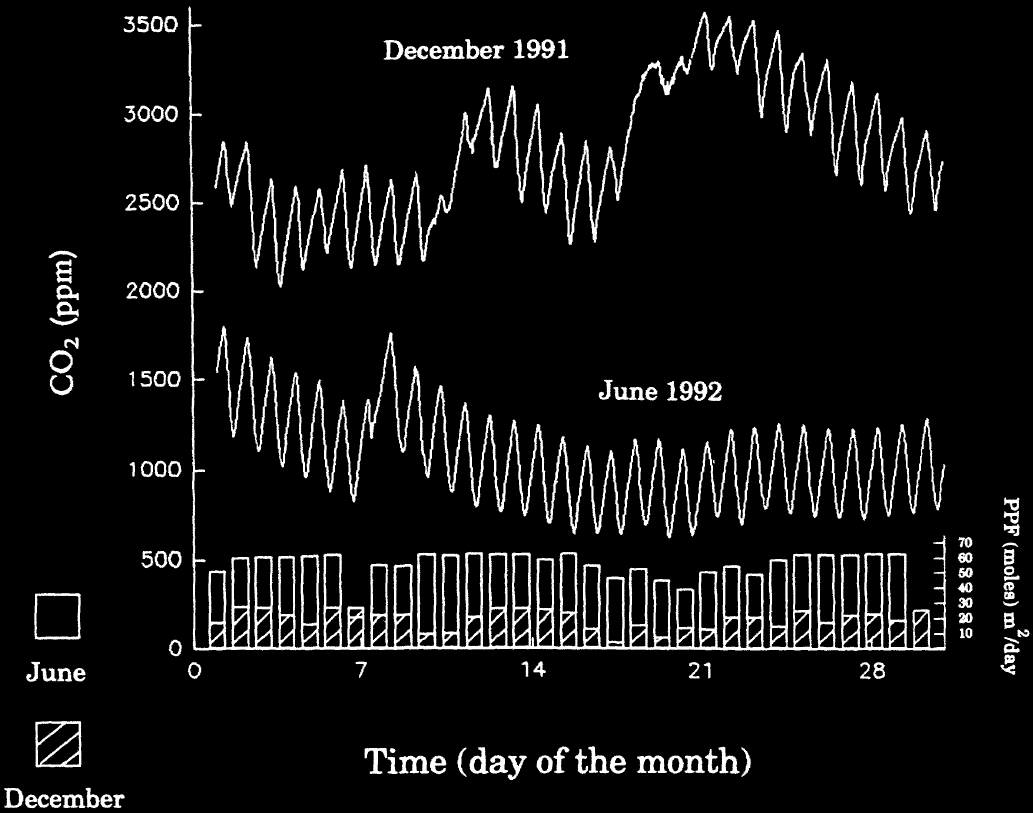Ever tried. Ever failed. No matter. Try Again. Fail again. Fail better.
-Samuel Beckett-
Biosphere 2 started as quite an ambitious challenge. It crammed five biomes into 3 acres of sealed facility and tried to create a mesocosm experiment. It was a “ship-in-a-bottle” style miniaturization of ecosystems; a tiny little man-made Hawaii in the Arizona desert (Hawaii is the only place on our planet where all biomes of the world, excepting Arctic Tundra exist). Biomes of the Biosphere 2 were ocean with coral reef, mangrove wetlands, tropical rainforest, savannah grassland and fog desert. There were also intensive agricultural areas for the inhabitants to sustain themselves. The experiment tested our basic ecological understanding of natural systems in an artifical mesocosm setting. How did the energy flow through organisms starting from photosynthesizers? How did materials (nutrients) cycled? It was a Henry David Thoreau style bold, naive but a suprisingly informative first attempt to simulate a self-sustaining environment for future space colonists. During the entire experiment, all of the crew’s waste, including waste from their domesticated animals, was recycled through natural, low-tech filtration methods. This pioneering work has led to a very successful subsurface water treatment system now used in many countries.
Engineering of the system was quite impressive. It had two major dome shaped “lungs” that compensate for the expansion and contraction of it’s atmosphere as a result of daily and seasonal temperature fluctuations. The entire system leaked 10 percent of its atmosphere over 2 years. As a comparison, Space Shuttles leaked on average 2 percent of their contained atmosphere during a 10 day mission.
Despite it’s controversial public image, Biosphere 2 recorded some pretty interesting biological and chemical events. These events helped us question and produce hypotheses on the chemistry and assembly of biological communities. Initial results indicated that the ecosystems in Biosphere 2 were functioning to maintain most of the introduced species but there were some shifts in the biological community and some species began to dominate some of the biomes. The humans were healthy and producing nearly all their food from the agricultural area. The cycling of nutrients such as carbon dioxide through the vegetation was operating with shorter periods and greater fluxes than in the global environment.
Biosphere 2 recorded some quite interesting biotic interactions. A rare species of amoeba, Euhyperamoeba biospherica, thrived in the waters of the Biosphere ocean. This giant amoeba of Caribbean origin is so ancestral that it still relies on symbiotic bacteria, instead of mitochondria, to generate metabolic energy. This was a curious reversal of the ocean biome into a primitive state. One has to keep in mind that the glass enclosure had triple layer of insulation which reduced the photosynthetically active radiation considerably. During the early geological history of our planet the sun was young and was less bright than it is today. Purple bacteria was the most efficient photosynthetic organism in early times. The amoeba that thrived in Biosphere 2 ocean might have been selected by the low irradiation conditions. This amoeba most probably fed on a type of cyanobacteria that were able to reproduce under lower irradiation.
In nature, ants make up only 3 percent of animal diversity yet they may constitute up to 50 percent of the total animal biomass in land habitats. Ant populations belonging to 11 species intentionally introduced to the enclosure showed a drastic change. These species were Camponotus sexguttatus (Fabr.), Camponotus ustus (Forel), Camponotus festinatus (Buckley), Camponotus mina Forel, Camponotus sp., Dorymyrmex insanus (Buckley) (formerly Conomyrma insana), Crematogaster steinheili (Forel), Crematogaster sp., Cyphomyrmex minutus Mayr, Forelius pruinosus Roger, and Pheidole sp. However an invasive ant species known as crazy ant (Paratrechina longicornis) competitively excluded all other ants. Additionaly, ant-resistant cockroaches increased in abundance. Other arthropods of significance were mostly Homopteran insects (leafhoppers, planthoppers, treehoppers, cicadas, aphids, psyllids, whiteflies, scale insects) that are ant mutualists. On an aquatic plant native to Florida called alligator flag (Thalia geniculata), the crazy ant were observed tending homopterans. Almost the entire nutrition for these ants came from honeydew produced by homopterans.
Through the experiment, the number of flying insects declined rapidly. These insects were pollinators of a majority of the plant species. Extinctions cascaded along the food chain. Out of 25 vertebrate species introduced, 19 went extinct. The emerald hummingbird (Amazilia amazilia) was chosen to pollinate a variety of plants inside the structure whose bill shape was most compatible. Males of this bird didn’t have the characteristic energetic mating display and was expected to survive without hitting the surrounding glass structure. The red-cheeked cordon bleu finch (Uraeginthus bengalus) also went extinct. A single curve-billed thrasher (Toxostoma curvirostre) that could never be captured and kept in the enclosure also died. Several house sparrows (Passer domesticus) that took residence inside before the enclosure was sealed continued to survive and were moving freely in between both wilderness and agriculture areas.
A species of bushbaby endemic to Africa, the northern greater galago (Galago garnetii) was introduced together with gum trees and fruit trees. They also ate insects. Galagos even reproduced inside the enclosure before going extinct. The major grass herbivore the leopard tortoise (Stigmochelys pardalis) was among the extinct vertebrates.
Among the vertebrate introduced were Australian blue-tongued skink (Tiliqua scindoides), prehensile skink (Corucia zebrata), and more than a dozen frog and lizard species. Recently, small scale enclosure experiments showed that salamanders could have a significant function in soil carbon budget by preying on leaf shredders and decreasing release of carbon in humid conditions. Salamanders were never included in Biosphere 2.
Apart from biotic interactions perhaps the most noticeable happening was the surge of carbon diokside and decrease in oxygen levels of the Biosphere 2 atmosphere. During the seasonal transition from Fall 1991 into Winter 1992 an exceptionally strong El Niño event produced a lot of clouds over Arizona. Inside Biosphere 2 carbon dioxide levels rose to about 3400 ppm in the last week of December when photosynthesis was greatly reduced. Atmospheric carbon diokside levels at one point reached 4800 ppm peak! As a result of this the ocean biome turned acidic by the dissolved excess carbon dioxide. Oxygen in the air dropped from 21 to 14 percent largely due to the cement floor used in construction. Additionally, this is what happened inside Biosphere 2: The soil was designed to function as a soil bed reactor to reduce trace gas buildups. When CO2 was elevated, plants photosynthesized more, but their leaves and roots and the soil bacteria respired more in parallel. It is now known that respiration of soil microorganisms can increase with warmer temperatures and even cancel out the carbon stored in plants.
Role of CO2 in ecosystem functioning is becoming increasingly important and Biosphere 2 showed that fluctuations that happen seasonally can become a much more intense daily occurrence in mesocosm scale. The mean turn over time for atmospheric CO2 is only 1-4 days, whereas in Earth’s atmosphere it could be about 3 years. As our planet is growing warmer and more carbon dioxide is continuing to be released, the question remains: with more carbon dioxide in the atmosphere and higher temperatures, would photosynthesis happening both on land plants and algae in water speed up by fixing more carbon?
In order to understand the effects of rising CO2 levels various institutions have been carrying out FACE experiments where atmospheric concentrations are increased in free gas exchange environments.
Land plants have evolved vascularization and are immensely influential on terrestrial water cycle through evapotranspiration. As the long-term observations from space accumulate we are beginning to understand the dynamics of global scale events. One of the consequences of the global climate change is increasingly frequent and intense droughts in tropical rainforests. Simulating drought in the rainforest mesocosm of Biosphere 2 can tell a lot about the volatile compounds released by plants during stress:
Plants set the pace of the biotic interactions. Global climate change will affect plant species distribution and that will cascade down the food chain. Plants included in the rainforest biome of the Biosphere 2 were predominantly Amazonian species. Rainforest habitats were meant to represent cloud forest, flood plain, stream, and lowland rainforest. Along three sides of the biome, a dense growth of plants in the order Zingiberales were planted like a belt to block the intense lateral desert sunlight. Between the rainforest and the ocean there was a wall of bamboo to reduce salt aerosol. The lowland rainforest had a canopy of fast-growing high light trees such as Cecropia peltata, white popinac (Leuceana glauca), and horseradish tree (Moringa oleifera). These trees were meant to be gradually replaced by the slower growing trees more characteristic of the mature rainforest such as mahogany (Swietenia macrophylla), rubber trees (Hevea brasiliensis), kapok (Ceiba pentandra), tree ferns, and palms. The expectation was to study succession of tropical biome. There were more than 300 species of higher plants in the Biosphere 2 rainforest, with initial biomass less than 10% of that expected at full growth. Since planted in November 1990 until it was resurveyed in July 1991, biomass increased approximately 50% in the rainforest. Since closure, the canopy structure has continued to develop rapidly, with some Leuceana trees grew more than 12-18 meters tall required pruning back from the frame. Branches got brittle and branchfalls occured just like the natural rainforests. Previously shaded trees were able to grow faster in those light gaps. The ginger belt also has developed vigorously, performing its role of sidelight screen.
Excessive condensation and humidity turned the intended desert biome into a chapparal. Mangrows brought from Florida however did exceptionally very well. They even established in a colony on corner of the Biosphere ocean by seed dispersal. So did the morning glory vines which had to be hand weeded since they began to choke the rainforest biome. The increase in abundance of vines and lianas in tropical forests is a striking observation by ecologists.
As also detailed in the main video of this post, Biosphere 2 has transitioned itself into a new goal of understanding landscape through water. Hydrology has always interested ecologists. How does water move through terrestrial landscapes? The new management of the Biosphere 2 aims to understand dynamics of rain, runoff, absorption by soil, use by plants, and evaporation with the help of three identical watersheds which will serve as replicates of a particular experiment:
LEO is in a way a laboratory-scale version of the famous Hubbard Brook Experimental Forest established by the U.S. Department of Agriculture (USDA) Forest Service in 1955 as a major center for hydrologic research in New England. The Hubbard Brook occupies a 3,037-ha (initially established) on an area where no major forest disturbance took place for more than 80 years. It is a bowl-shaped valley sitting on a relatively impermeable bedrock. It has well-defined watershed boundaries and almost homogeneous geologic features, soil types, vegetation and climate; evenly distributed precipitation and perennial streamflow. Streamflow is measured accurately by weirs constructed at the bottom of every watershed. Moreover, several adjacent similar-sized catchments enables experimental manipulation of entire watersheds. Which is indeed what is planned in the LEO design with three watersheds with identical inclination.
Biosphere 2 was a bold and progressive step towards designing materially sealed human habitations. It laid foundation for modern intensive indoors indoors agricultural systems and passed the torch from Conshelf underwater habitation experiment to other artificial human habitats such as International Space Station. It was also a psychological experiment probing human nature in long-term enclosures.





8 Comments
Nice video! LEO is a fascinating project that I would love to visit and be able to monitor the research done there. The concepts behing this bio-dome research facility are one of a kind. I need to emphasize that this is cool once more… An experimental facility like this should yield much more control than the current ways to test many natural scientific principles and methods of understanding the interrelations between living organisms and nonliving physical parts of an environment like nutrient cycling, hydrology, plant physiology, ecology, efjemnqrjology, and any of the other ology’s left out. Though the only concern I have is that there is so many more things to add to an experimental facility like this to discover the secrets of natural systems even more. Post more videos in this category please.
-Alex Gordon
Environmental Engineering Major, GPC
Alpharetta’s EGO (Environmentally Green Org.) President
BBC’s Science in Action program has full coverage on Biosphere 2: http://www.bbc.co.uk/programmes/p0395yqx